Nano-Phase and SiC–Si Spherical Microstructure in SiC/Al-50Si Composites Solidified under High Pressure
Abstract
1. Introduction
2. Experimental Procedures
3. Results and Discussion
3.1. Microstructure
3.2. Formation Mechanism of SiC–Si Spherical Microstructure
3.3. Nano-Phase Precipitation
3.4. Mechanical Properties
4. Conclusions
- (1)
- The high melt viscosity under HP makes the SiC particles almost “fixed” in situ. The presence of SiC in the growth front of the primary Si will hinder its continued growth and eventually form a SiC–Si spherical microstructure.
- (2)
- The solid solubility of Si in the Al matrix was increased from 2.5–2.6 at.% at 1 GPa to 8.1–8.7 at.% at 3 GPa. Through aging treatment, a large number of dispersed nanoscale Si phases are precipitated in the α-Al supersaturated solid solution. A semi-coherent interface is formed between the α-Al matrix and the nanoscale Si precipitates.
- (3)
- The bending strength of the aged SiC/Al-50Si composites prepared at 3 GPa is 387.6 MPa, which is 18.6% higher than that of the unaged composites.
Author Contributions
Funding
Institutional Review Board Statement
Informed Consent Statement
Data Availability Statement
Conflicts of Interest
References
- Zhao, Q.; Ju, B.; Zhao, K.; Zhan, J.; Liu, M.; Zhang, N.; Qian, J.; Xiu, Z.; Kang, P.; Yang, W. Effect of Reinforcement Size on Mechanical Behavior of SiC-Nanowires-Reinforced 6061Al Composites. Materials 2022, 15, 8484. [Google Scholar] [CrossRef]
- Sager, A.; Esen, I.; Ahlatçi, H.; Turen, Y. Dry Wear Behaviour of the New ZK60/AlN/SiC Particle Reinforced Composites. Materials 2022, 15, 8582. [Google Scholar] [CrossRef] [PubMed]
- Abd El Aal, M.I.; El-Fahhar, H.H.; Mohamed, A.Y.; Gadallah, E.A. The Mechanical Properties of Aluminum Metal Matrix Composites Processed by High-Pressure Torsion and Powder Metallurgy. Materials 2022, 15, 8827. [Google Scholar] [CrossRef] [PubMed]
- Ward, P.J.; Atkinson, H.V.; Anderson, P.R.G.; Elias, L.G.; Garcia, B.; Kahlen, L.; Rodriguez-ibabe, J.-M. Semi-Solid Processing of Novel MMCs Based on Hypereutectic Aluminium-Silicon Alloys. Acta Mater. 1996, 44, 1717–1727. [Google Scholar] [CrossRef]
- Han, B.; Liu, S.; Wang, X.; Liang, Y.; Xia, Y.; Cui, C. Simultaneously Improving Strength and Ductility of Hybrid Al–Si Matrix Composite with Polyphasic and Multi-Scale Ceramic Particles. Mater. Sci. Eng. A 2021, 804, 140517. [Google Scholar] [CrossRef]
- Jiang, T.; Fu, J.; Xu, B.; Xu, G. The Influence on Microstructure and Wear Behavior of Hypereutectic Al-50Si Alloy with Various Cu-P Admixture Contents and Cooling Rates. Surf. Topogr. Metrol. Prop. 2019, 7, 035008. [Google Scholar] [CrossRef]
- Segurado, J.; González, C.; LLorca, J. A Numerical Investigation of the Effect of Particle Clustering on the Mechanical Properties of Composites. Acta Mater. 2003, 51, 2355–2369. [Google Scholar] [CrossRef]
- Peng, H.X.; Fan, Z.; Evans, J.R.G. Bi-Continuous Metal Matrix Composites. Mater. Sci. Eng. A 2001, 303, 37–45. [Google Scholar] [CrossRef]
- Peng, H.X.; Fan, Z.; Evans, J.R.G. Factors Affecting the Microstructure of a Fine Ceramic Foam. Ceram. Int. 2000, 26, 887–895. [Google Scholar] [CrossRef]
- Lasagni, F.; Acuña, J.A.; Degischer, H.P. Interpenetrating Hybrid Reinforcement in Al2O3 Short Fiber Preforms Infiltrated by Al-Si Alloys. Metall. Mater. Trans. A 2008, 39, 1466–1474. [Google Scholar] [CrossRef]
- Requena, G.C.; Degischer, P.; Marks, E.D.; Boller, E. Microtomographic Study of the Evolution of Microstructure during Creep of an AlSi12CuMgNi Alloy Reinforced with Al2O3 Short Fibres. Mater. Sci. Eng. A 2008, 487, 99–107. [Google Scholar] [CrossRef]
- Lasagni, F.; Degischer, H. Enhanced Young’s Modulus of Al-Si Alloys and Reinforced Matrices by Co-continuous Structures. J. Compos. Mater. 2010, 44, 739–755. [Google Scholar] [CrossRef]
- Bai, F.; Bian, K.; Huang, X.; Wang, Z.; Fan, H. Pressure Induced Nanoparticle Phase Behavior, Property, and Applications. Chem. Rev. 2019, 119, 7673–7717. [Google Scholar] [CrossRef]
- Zhang, L.; Wang, Y.; Lv, J.; Ma, Y. Materials Discovery at High Pressures. Nat. Rev. Mater. 2017, 2, 17005. [Google Scholar] [CrossRef]
- Flores-Livas, J.A.; Boeri, L.; Sanna, A.; Profeta, G.; Arita, R.; Eremets, M. A Perspective on Conventional High-Temperature Superconductors at High Pressure: Methods and Materials. Phys. Rep. 2020, 856, 1–78. [Google Scholar] [CrossRef]
- Miao, M.; Sun, Y.; Zurek, E.; Lin, H. Chemistry under High Pressure. Nat. Rev. Chem. 2020, 4, 508–527. [Google Scholar] [CrossRef]
- Mostafa, A.; Adaileh, W.; Awad, A.; Kilani, A. Mechanical Properties of Commercial Purity Aluminum Modified by Zirconium Micro-Additives. Crystals 2021, 11, 270. [Google Scholar] [CrossRef]
- MacLeod, S.G.; Errandonea, D.; Cox, G.A.; Cynn, H.; Daisenberger, D.; Finnegan, S.E.; McMahon, M.I.; Munro, K.A.; Popescu, C.; Storm, C.V. The Phase Diagram of Ti-6Al-4V at High-Pressures and High-Temperatures. J. Phys. Condens. Matter 2021, 33, 154001. [Google Scholar] [CrossRef]
- Holzapfel, W.B. Physics of Solids under Strong Compression. Rep. Prog. Phys. 1996, 59, 29. [Google Scholar] [CrossRef]
- San-Miguel, A. Nanomaterials under High-Pressure. Chem. Soc. Rev. 2006, 35, 876–889. [Google Scholar] [CrossRef]
- Zhang, R.; Zou, C.M.; Wei, Z.J.; Wang, H.W.; Liu, C. Interconnected SiC–Si Network Reinforced Al–20Si Composites Fabricated by High Pressure Solidification. Ceram. Int. 2021, 47, 3597–3602. [Google Scholar] [CrossRef]
- Ma, P.; Wei, Z.J.; Jia, Y.D.; Zou, C.M.; Scudino, S.; Prashanth, K.G.; Yu, Z.S.; Yang, S.L.; Li, C.G.; Eckert, J. Effect of High Pressure Solidification on Tensile Properties and Strengthening Mechanisms of Al-20Si. J. Alloys Compd. 2016, 688, 88–93. [Google Scholar] [CrossRef]
- Ma, P.; Zou, C.M.; Wang, H.W.; Scudino, S.; Fu, B.G.; Wei, Z.J.; Kühn, U.; Eckert, J. Effects of High Pressure and SiC Content on Microstructure and Precipitation Kinetics of Al–20Si Alloy. J. Alloys Compd. 2014, 586, 639–644. [Google Scholar] [CrossRef]
- Ma, P.; Wei, Z.J.; Jia, Y.D.; Yu, Z.S.; Prashanth, K.G.; Yang, S.L.; Li, C.G.; Huang, L.X.; Eckert, J. Mechanism of Formation of Fibrous Eutectic Si and Thermal Conductivity of SiCp/Al-20Si Composites Solidified under High Pressure. J. Alloys Compd. 2017, 709, 329–336. [Google Scholar] [CrossRef]
- Wei, Z.; Ma, P.; Wang, H.; Zou, C.; Scudino, S.; Song, K.; Prashanth, K.G.; Jiang, W.; Eckert, J. The Thermal Expansion Behaviour of SiCp/Al–20Si Composites Solidified under High Pressures. Mater. Des. 2015, 65, 387–394. [Google Scholar] [CrossRef]
- Bean, V.E.; Akimoto, S.; Bell, P.M.; Block, S.; Holzapfel, W.B.; Manghnani, M.H.; Nicol, M.F.; Stishov, S.M. Another Step toward an International Practical Pressure Scale: 2nd AIRAPT IPPS Task Group Report. Physica B + C 1986, 139–140, 52–54. [Google Scholar] [CrossRef]
- Zhang, R.; Zou, C.; Wei, Z.; Wang, H. Effect of High Pressure and Temperature on the Evolution of Si Phase and Eutectic Spacing in Al-20Si Alloys. Crystals 2021, 11, 705. [Google Scholar] [CrossRef]
- Huang, X.; Han, Z.; Liu, B. Study on the Effect of Pressure on the Equilibrium and Stability of the Solid-Liquid Interface in Solidification of Binary Alloys. Sci. China Technol. Sci. 2011, 54, 479–483. [Google Scholar] [CrossRef]
- Schmitz, J.; Hallstedt, B.; Brillo, J.; Egry, I.; Schick, M. Density and Thermal Expansion of Liquid Al–Si Alloys. J. Mater. Sci. 2012, 47, 3706–3712. [Google Scholar] [CrossRef]
- Bendijk, A.; Delhez, R.; Katgerman, L.; De Keijser, T.H.; Mittemeijer, E.J.; Van Der Pers, N.M. Characterization of Al-Si-Alloys Rapidly Quenched from the Melt. J. Mater. Sci. 1980, 15, 2803–2810. [Google Scholar] [CrossRef]
- Meredith, P.G. Fracture and Failure of Brittle Polycrystals: An Overview. In Deformation Processes in Minerals, Ceramics and Rocks; Barber, D.J., Meredith, P.G., Eds.; Springer: Dordrecht, The Netherlands, 1990; pp. 5–47. ISBN 978-94-011-6827-4. [Google Scholar]
- Jia, B.; Rusinek, A.; Pesci, R.; Bernier, R.; Bahi, S.; Bendarma, A.; Wood, P. Simple Shear Behavior and Constitutive Modeling of 304 Stainless Steel over a Wide Range of Strain Rates and Temperatures. Int. J. Impact Eng. 2021, 154, 103896. [Google Scholar] [CrossRef]
- Ye, J.; Han, B.Q.; Lee, Z.; Ahn, B.; Nutt, S.R.; Schoenung, J.M. A Tri-Modal Aluminum Based Composite with Super-High Strength. Scripta Mater. 2005, 53, 481–486. [Google Scholar] [CrossRef]
- Cai, Z.; Zhang, C.; Wang, R.; Peng, C.; Wu, X.; Li, H. Microstructure, Mechanical and Thermo-Physical Properties of Al–50Si–XMg Alloys. Mater. Sci. Eng. A 2018, 730, 57–65. [Google Scholar] [CrossRef]
- Yu, S.; Wang, R.; Peng, C.; Cai, Z.; Wu, X.; Feng, Y.; Wang, X. Effect of Minor Scandium Addition on the Microstructure and Properties of Al–50Si Alloys for Electronic Packaging. J. Mater. Sci. Mater. Electron. 2019, 30, 20770–20777. [Google Scholar] [CrossRef]
- Luo, J.; Wang, R.; Peng, C.; Cai, Z.; Feng, Y.; Wang, X. Precipitation Behavior and Properties of Al–50Si–0.5X (X = Sc, La, Nb) Alloys. J. Mater. Sci. Mater. Electron. 2022, 33, 7380–7395. [Google Scholar] [CrossRef]
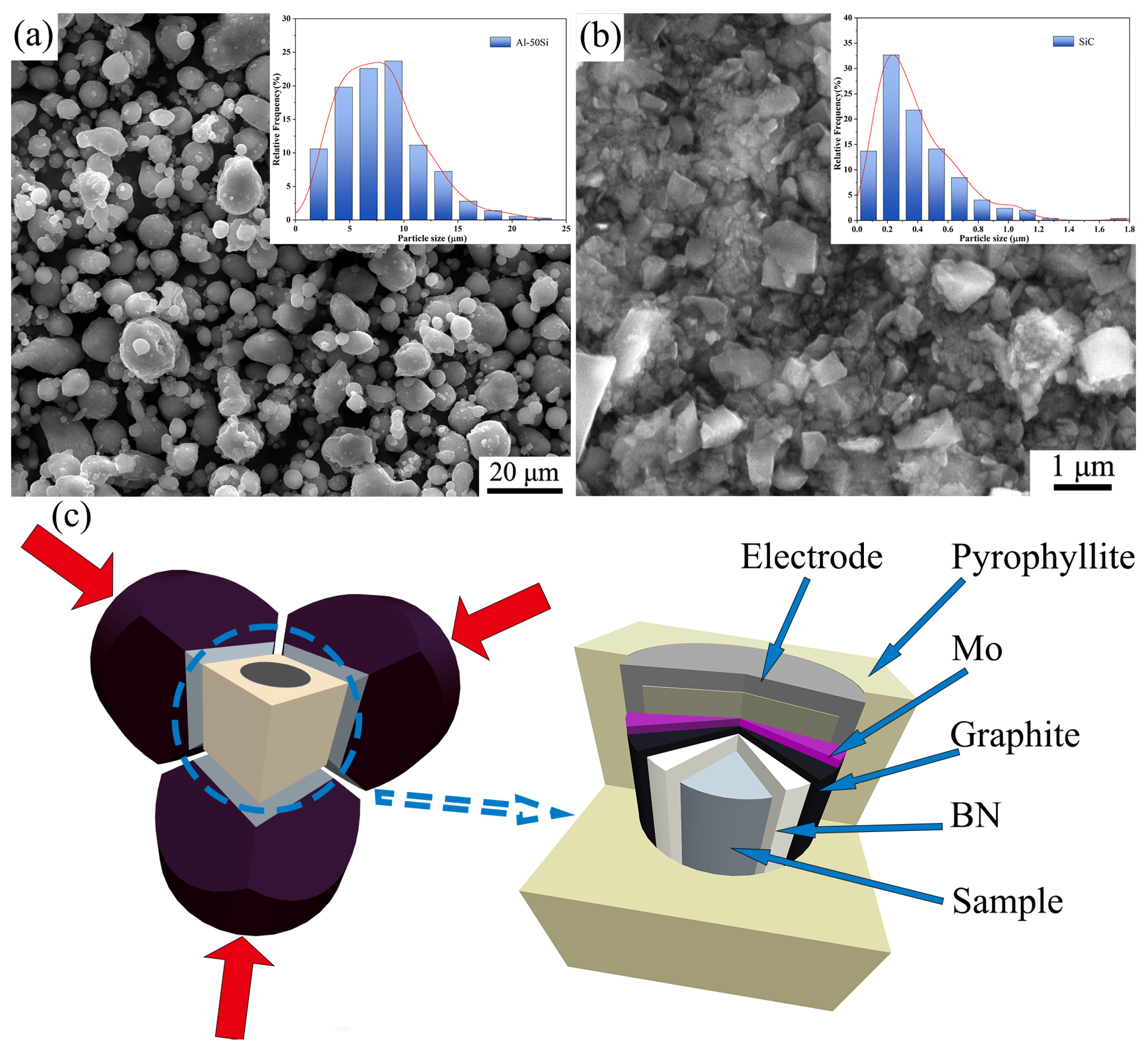
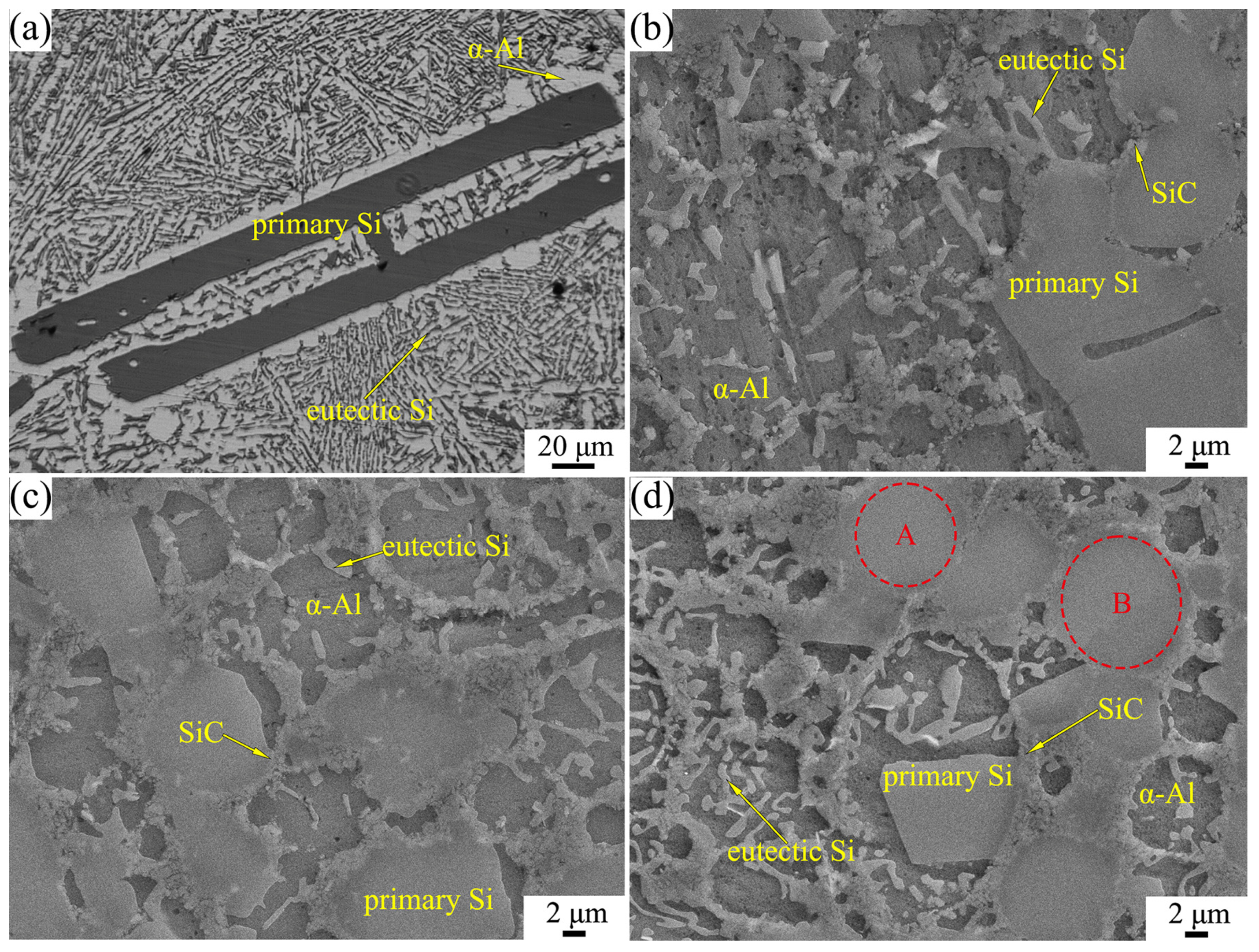

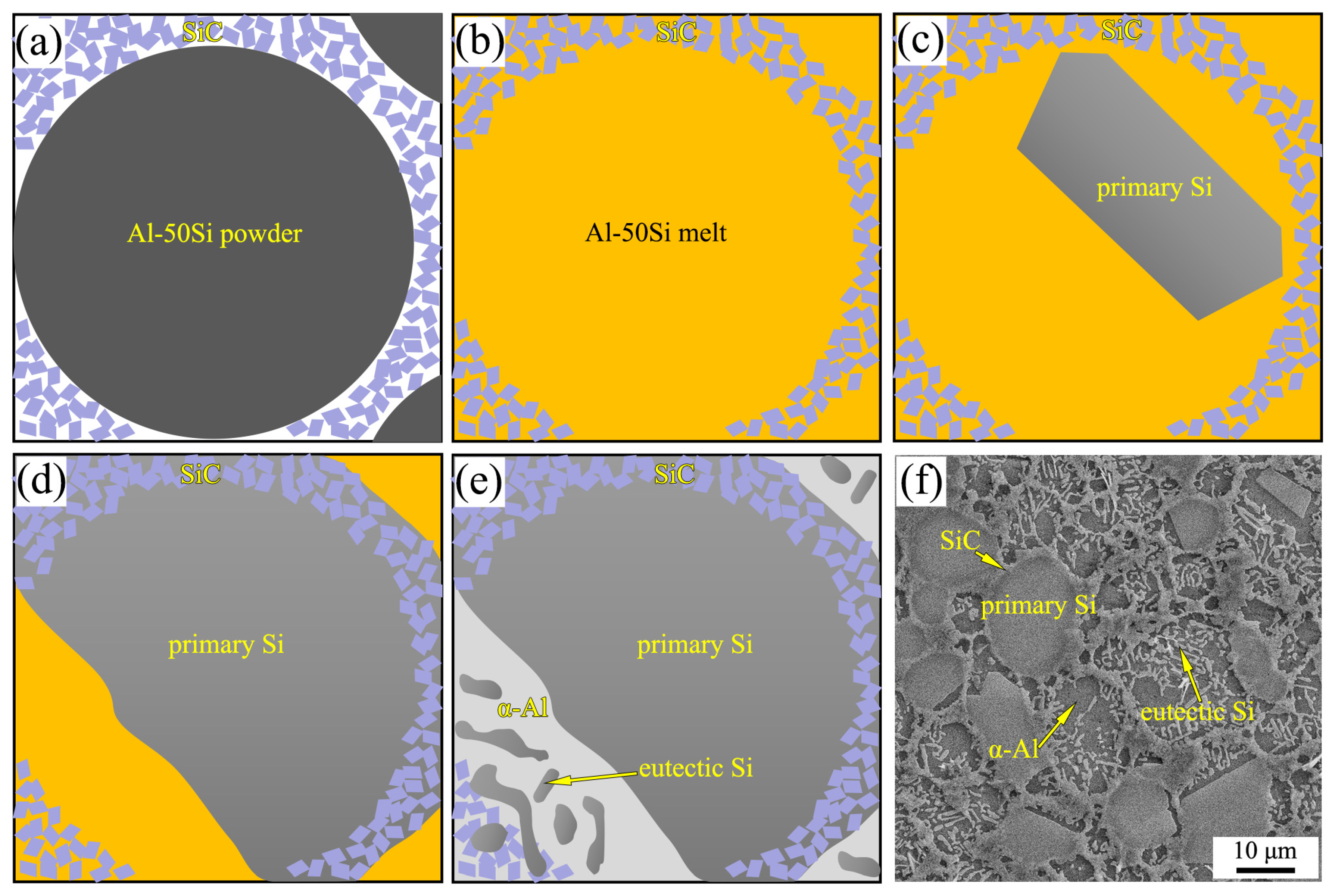
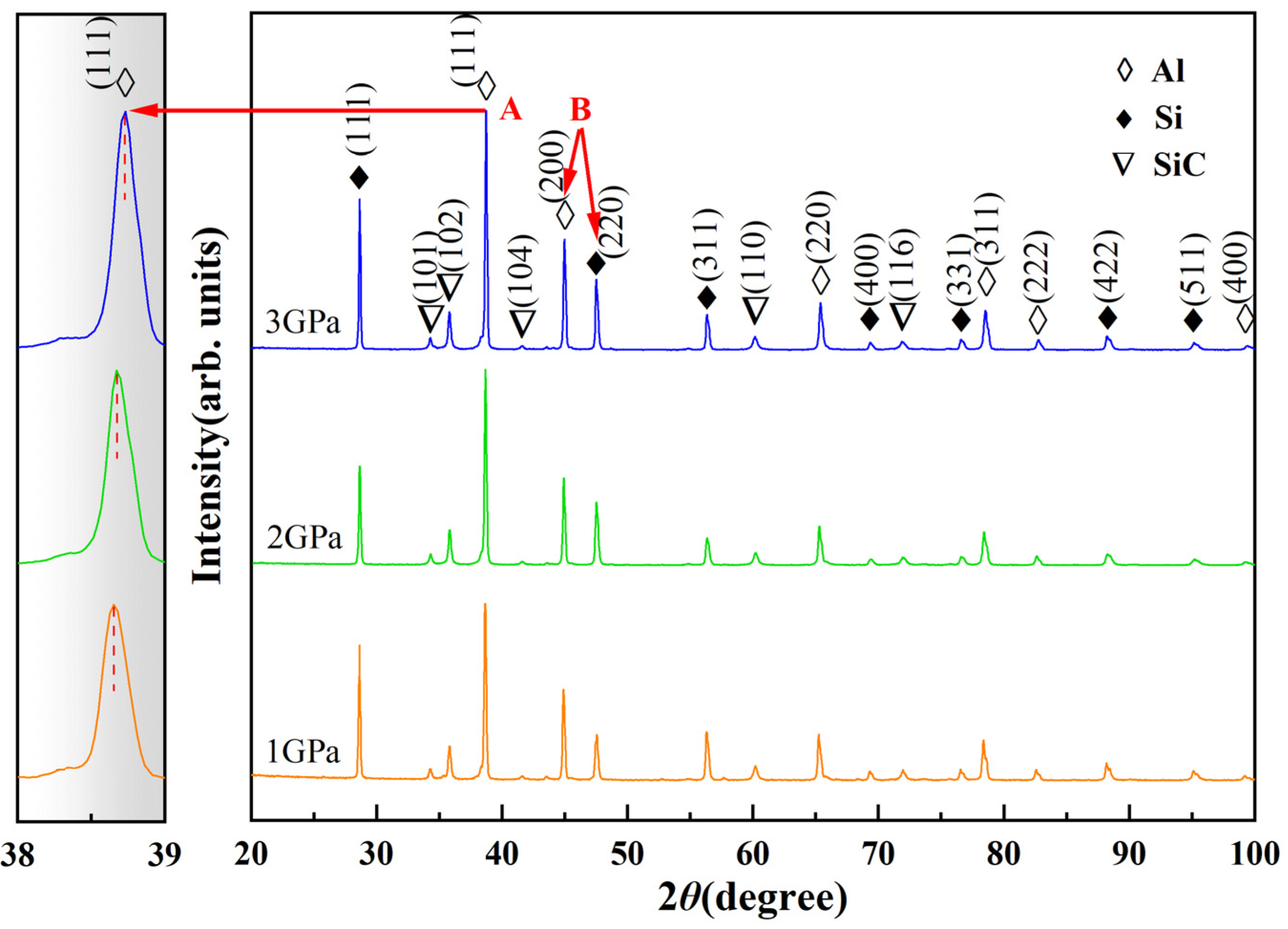
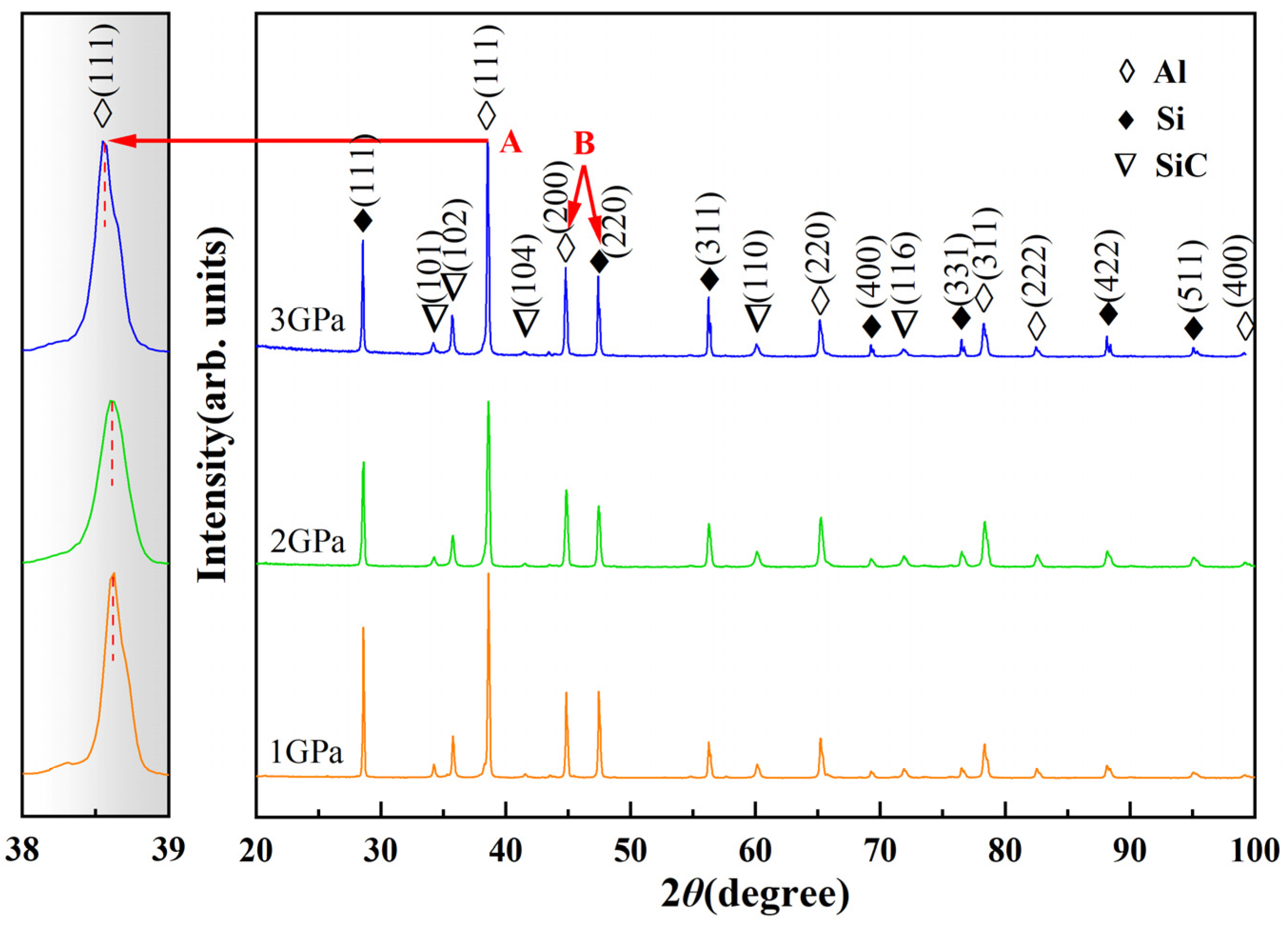


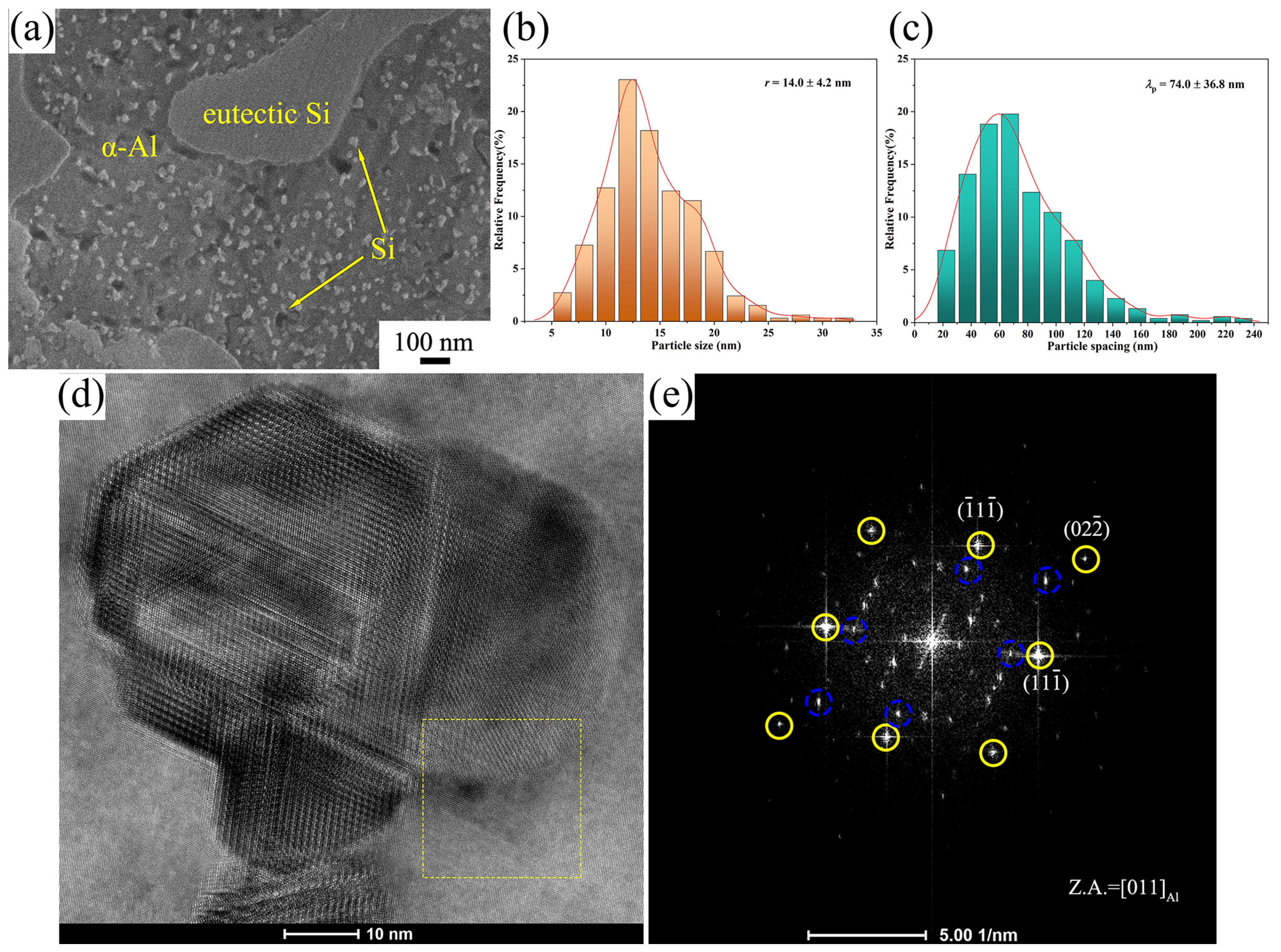
| P (GPa) | aAl (nm) | xSi (at.%) (Homogeneous) | xSi (at.%) (Si-Rich) |
|---|---|---|---|
| 1 | 0.40446 | 2.6 | 2.5 |
| 2 | 0.40393 | 5.6 | 5.4 |
| 3 | 0.40340 | 8.7 | 8.1 |
| Matrix (wt.%) | Added Elements or Reinforcements | Bending Strength (MPa) | Fabrication Route | References |
|---|---|---|---|---|
| Al-50Si | 287.9 | Hot pressing + Aging | [34] | |
| Al-50Si | 0.3 wt.% Sc | 331 | Hot pressing | [35] |
| Al-50Si | 0.5 wt.% Sc | 309.6 | Hot pressing | [36] |
| Al-50Si | 0.5 wt.% La | 321.5 | Hot pressing | [36] |
| Al-50Si | 0.5 wt.% Nb | 337.2 | Hot pressing | [36] |
| Al-50Si | 1 wt.% Mg | 405.1 | Hot pressing + Aging | [34] |
| Al-50Si | 20 vol.% SiC | 387.6 | HP + Aging | This work |
Disclaimer/Publisher’s Note: The statements, opinions and data contained in all publications are solely those of the individual author(s) and contributor(s) and not of MDPI and/or the editor(s). MDPI and/or the editor(s) disclaim responsibility for any injury to people or property resulting from any ideas, methods, instructions or products referred to in the content. |
© 2023 by the authors. Licensee MDPI, Basel, Switzerland. This article is an open access article distributed under the terms and conditions of the Creative Commons Attribution (CC BY) license (https://creativecommons.org/licenses/by/4.0/).
Share and Cite
Zhang, R.; Zou, C.; Wei, Z.; Wang, H.; Liu, C. Nano-Phase and SiC–Si Spherical Microstructure in SiC/Al-50Si Composites Solidified under High Pressure. Materials 2023, 16, 4283. https://doi.org/10.3390/ma16124283
Zhang R, Zou C, Wei Z, Wang H, Liu C. Nano-Phase and SiC–Si Spherical Microstructure in SiC/Al-50Si Composites Solidified under High Pressure. Materials. 2023; 16(12):4283. https://doi.org/10.3390/ma16124283
Chicago/Turabian StyleZhang, Rong, Chunming Zou, Zunjie Wei, Hongwei Wang, and Chuang Liu. 2023. "Nano-Phase and SiC–Si Spherical Microstructure in SiC/Al-50Si Composites Solidified under High Pressure" Materials 16, no. 12: 4283. https://doi.org/10.3390/ma16124283
APA StyleZhang, R., Zou, C., Wei, Z., Wang, H., & Liu, C. (2023). Nano-Phase and SiC–Si Spherical Microstructure in SiC/Al-50Si Composites Solidified under High Pressure. Materials, 16(12), 4283. https://doi.org/10.3390/ma16124283





